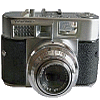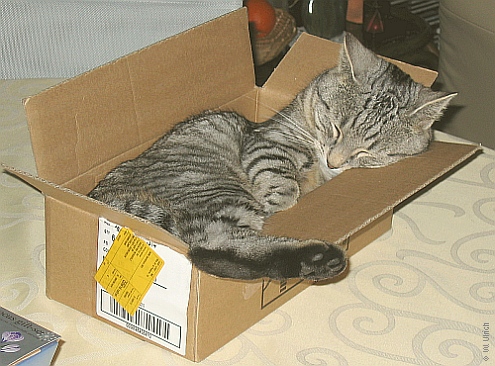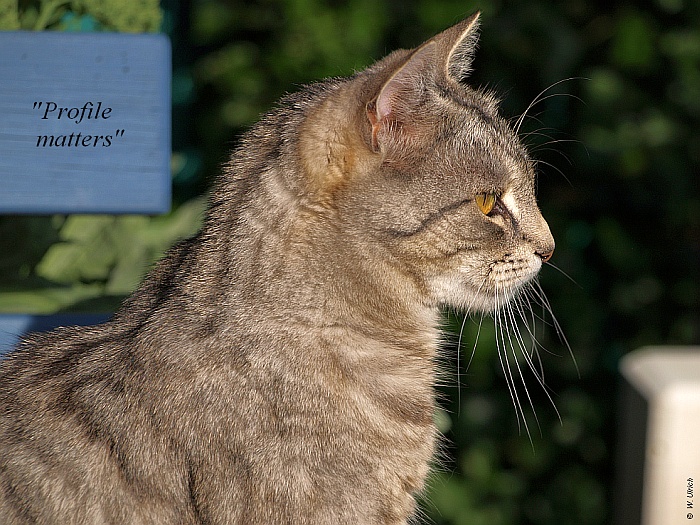Werner Ulrich's Home Page: Ulrich's Bimonthly
Formerly "Picture of the Month"
September-October
2012
Profile Matters

Mini matters For once, I want to offer a Bimonthly that is inspired by a photo rather than my current academic work. It is a photo of one of our cats, introduced to my readers on an earlier occasion as (the) Mini. Mini recently suffered a severe accident, presumably a collision with a car. He was in very bad shape but is now slowly recovering. He therefore is very much in the center of our attention and concern these days.
I love this animal. He is such a beautiful soul, a faithful friend, a beautiful creature in every sense of the word. It occurred to me that one of my favorite photographs of Mini shows him in profile. I find the profile of his face and head particularly beautiful and characteristic. It matters for the way I see and love him. Thus emerged the theme of this Bimonthly: "profile matters."
It is a modest, unambitious Bimonthly. All I intend is to offer a few fragmentary thoughts on the appeal and importance of "profile" in our contemporary lives. I articulate them with no attempt whatsoever to do justice to the topic, I merely put down in writing some of the spontaneous associations this picture evokes in me along with feelings of affection and concern for Mini.
The etymology of "profile" The word "profile" comes from the Latin composed verb pro-filare, whereby pro means forth and filare means to spin a thread. So the composed verb means to draw an outline or contour as if with a thread, whence comes the derived Latin noun profilo, a drawing in outline.
In modern English, a "profile," according to The Concise Oxford English Dictionary, is a noun meaning:
1 an outline (esp. of a human face) as seen from one side.
2 a short biographical or character sketch.
3 Statistics a representation by a graph or chart of information (esp. on certain characteristics) recorded in a quantified form.
4 a characteristic personal manner or attitude.
5 a vertical cross-section of a structure.
6 a flat outline piece of scenery on stage.
(The Concise Oxford Dictionary of Current English, 9th ed. of 1995)
Further, as a transitive verb, "to profile" means to:
1 represent in profile.
2 give a profile to.
|
|
For a hyperlinked overview of all issues
of "Ulrich's Bimonthly" and the previous "Picture of the
Month" series,
see the site map
Some fragmentary thoughts on "profile" Profile is a key factor of success in many fields of practice, ranging from professional and academic practice to art, politics, and commercial enterprise. Profile has much in common with branding, with developing a person's or a product's unique character and identity. Outstanding design of a product for example, is not just functional but also gives it an unmistakable identity, makes it a statement of personal taste and identity, sometimes even of a way of life. In the world of marketing and advertising, profile – visibility, identity, image – is important. For example, a journal or newspaper's appeal and success largely depends on its "profile," that is, its thematic focus and particular mix of topics, the originality and quality of what it publishes, the high-profile editorial board members who support it, the support it offers its authors, and so on. To promote a journal means to develop its profile in all these respects, as I recently have experienced through intensive involvement with the Journal of Research Practice (JRP).
In professional practice, one's profile of expertise and experience is crucial for recognition as a competent practitioner in a field. In an academic career, a university teacher's or researcher's profile demands original thinking and dedication to sharing one's ideas with others through teaching, publishing, and practical engagement, along with a good sense of what is relevant and timely. Similarly, in an artist's career, creativity and originality of expression are key to an artist's profile. In a business career, one's profile of management skills and experiences, along with a "network" (the profile of your smart phone's address book, as it were), largely determine the chances of promotion. Last but not least, profile certainly matters in a political career: we tend to appreciate politicians with a well-defined, recognizable profile of views and values – politicians "with rough edges," mit Ecken und Kanten as the Germans say – so that as voters we know what they stand for.
But mind you, too much is bad (obviously so by definition, not always quite so obviously in real life): when the quest for profile begins to dominate the quest for good practice, it risks becoming a profile neurosis. One senses the intention and feels put off, as the intention which comes to light is a disconcerting one. High-profile people in all areas of life often walk a thin line between profile cultivation and profile neurosis. If profile becomes the main preoccupation, it loses its validity, as it were. Profile needs to be earned, it must "fit" the person who claims or displays it.

Profile
must fit, otherwise it is disturbing
As profile becomes ever more important, new social forms to articulate and present it develop rapidly. In scholarship, for example, thanks to the development of new resources such as online academic communities and citation indices, a researcher's academic profile can now be captured and shared in the new form of a Google Scholar "citations profile." I recently decided to keep up with the times and to offer a link to my citations profile in the entry page to this web site. So, if you haven't seen a Google Scholar citations profile and wonder how it looks, hit the "Home" button in the left-hand menu and then find the link to my citations profile in the right upper corner of the page that opens.
In a different sense, profile matters for the quality of judgment: recognizing (rather than owning) it is vital for the success of professional intervention, I mean the importance of appreciating the uniqueness of a situation in which one intervenes as a practically engaged problem-solver or decision-maker, professional or researcher. Good situational judgment depends on identifying a situation's unique profile before one tries to apply lessons learned from other situations and/or general theories and methods. Likewise, prior to taking action to improve some situation or overcome a problem, it matters to be clear about the profile of requirements for a "good" solution. Or before a company hires a new employee or even an executive, it certainly matters to work out a clear job profile and define a corresponding requirements profile for the future collaborator.
But profile is not only a means to professional or commercial ends; it is also part of our identity and happiness as private persons. How friends and family members see us and treat us has much to do with how they see our profile as persons, for example, our strengths and weaknesses, our insights and errors, our virtues and vices. Hobbies and special talents (say, artistic or rhetorical talents, mastering several languages, etc.), as well as particular experiences we have made (e.g., having lived and worked in different parts of the word, or having exercised different professions), add to our profile as private persons no less than to our professional profile; more importantly, they make us more interesting persons for ourselves as for others. Over the years I have discovered that an essential skill in the quest for a contented life consists in learning to be one's own good company; I've found that cultivating different skills and experiences allows me to enjoy my own company, which is not to say I always succeed!
Developing a rich and distinctive personal profile may, at the same time, make us vulnerable. As users of online services, for example, we better are careful about our user profile, that is, the data we reveal as part of our online identity and the electronic footprint that we leave in the Internet and in data banks by our online activities, though not always deliberately. As an author, to take another example, I have learned that it is difficult to defend my ideas against commentators and critics who do not really bother to study and understand, and to give fair accounts, before they comment and criticize. The result has in some cases been a corrupted history of ideas in which I cannot always recognize a valid profile of my academic endeavors. Scholarly means can achieve little against those who do not see their value and instead resort to other means of making their mark, ranging from simple (often superficial) copying or paraphrasing without giving accurate credits to misrepresentation and outright plagiarism. Such vulnerabilities are apparently the price we have to pay today for the ease of access to information and of sharing our ideas that the Internet affords us.
Finally, profile is appealing. It can be related to beauty and what is beautiful in life. As artists know, real beauty is not the same as flawlessness, it need not be perfect (Leonardo da Vinci's Mona Lisa is the exception that confirms the rule). Rather, it gains appeal through irregularities, through what is peculiar about a face, a person, or an object. It is proverbial that when we love someone, we also love her or his flaws; we love a person for her entire set of characteristics – her "character" – not just for her nice and pleasant sides. In photography, highlighting a subject's particular profile is what makes a photograph interesting; I am thinking, for example, of the texture and lines that characterize a face, or the patterns of light and shade that characterize a winter landscape. As this Bimonthly's picture illustrates, the appeal of profile holds true even for animal photography. Even if you are a cat, "profile matters," at least to the photographer!
|
September 2012
|
|---|
|
October 2012
|
|---|
Picture data Digital photograph taken on 28 July 2010 around 8:30 a.m. ISO 100, exposure mode aperture priority, aperture f/5.0, exposure time 1/1250 seconds, exposure bias -0.7; focal length 98 mm (equivalent to 196 mm with a conventional 35 mm camera), metering mode multi-segment, contrast soft, saturation high, sharpness soft. Original resolution 3648 x 2736 pixels; current resolution 700 x 500 pixels, compressed to 203 KB.
September-October, 2012
| Mini the cat's photographic profile |
„Profile matters”
Notepad for capturing personal thoughts »
|
Personal notes:
Write
down your thoughts before
you forget them! |
|
Last
updated 22 Jun 2014 (title layout), 1 Sep 2012 (text);
first published 1 Sep 2012
https://wulrich.com/bimonthly_september2012.html
